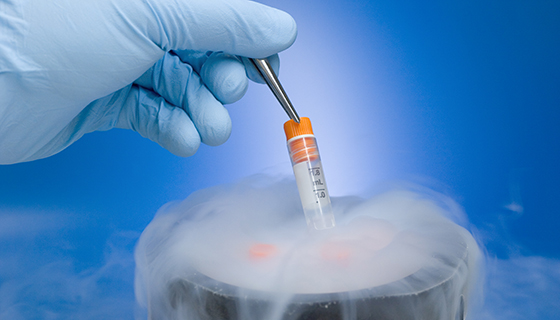


Embryo freezing involves in vitro fertilization, a procedure in which eggs are removed from a woman’s ovary and combined with sperm in the laboratory to form embryos. The embryos are frozen and can later be thawed and placed in a woman’s uterus. Embryo freezing is a type of fertility preservation.
Freezing the embryos is the first step of embryo cryopreservation. The frozen embryos are then stored and later thawed, as needed, for future use in IVF. This allows patients currently undergoing IVF to save time and money on future cycles because a woman will not need to undergo additional egg retrievals and take as many medications.
Firstly, you’ll need to be tested for any infectious diseases like HIV and hepatitis. Not all embryos are suitable for freezing so only good quality embryos will be chosen to freeze. Embryos can be frozen at different stages of their development – when they’re just a single cell, at the two to eight cell stage or later in their development (called the blastocyst stage).
To create an embryo (a fertilized egg), an embryologist fertilizes one or more of the harvested eggs with the sperm of a partner or donor. The embryo is observed as it grows in a petri dish for five to seven days. At this stage, embryos can be sampled for genetic testing, especially if the egg or sperm donor is known to be a carrier of certain genetic conditions. The embryos are graded to determine the ones most likely to grow successfully when implanted.
At this point, the highly graded embryos can be frozen. This process, also called vitrification, replaces the water in the embryo cells with a protectant fluid, and uses flash-freezing with liquid nitrogen to prevent the formation of ice crystals that could damage the cells of the embryo.
Research shows that the freezing and thawing of embryos does not harm subsequent babies made through IVF. The length of time the embryo was stored does not affect IVF success rates.
With improving technology, the difference in pregnancy rates between frozen embryos and fresh is negligible. In addition, the stimulation process with frozen embryo transfer is gentler, with hormone levels closer to normal in the woman, which may also improve pregnancy rates.
Any ice crystals formed during the slow freeze process may cause damage to an embryo while thawing. This is one of the reasons vitrification is the preferred cryopreservation technique. Research shows that there is no increase in the risk of birth defects among children born from frozen embryos compared with normal births.
Well, the defreezing process is known as thawing. When embryos are needed, it is taken out from the liquid nitrogen container and placed in the water bath where the temperature is made to rise gradually. As the temperature raises the cryoprotectants leaves the embryos. To limit the effect of the leaving cryoprotectants, a stepwise dilution process is done.
If you are struggling to get pregnant, it is never too late to turn towards advancing reproductive medicines and technologies for help! You can even consult with your healthcare specialist for more options and information.